Do Most Couples Now Meet Online?
Much has been made of the rise of online dating and especially dating apps like Tinder in the past decade. Everyone will have seen this graph showing couples meeting online shooting up to nearly 40% in 2017:

This graph which added data from two follow up surveys and filtered out the ‘bar’ responses who initially met online (they were sorted into whichever categories their written description fit which could be multiple) has been making the rounds:
Wow, it’s apparently well past the 50% mark now with no breaks in sight. Is society really this terminally online?
First let’s examine other sources to see if they yield consistent results. It’s never good to put all your eggs in one basket if you can help it.
What Do Other Sources Say?
A Pew Research survey conducted in October of 2019 found that only 28% of straight people had ever used a dating site or app, period, and only 11% had been in a committed relationship with someone they met on one. Even of 18-29s, about half had never used online dating, and 83% hadn’t been in a relationship through it.
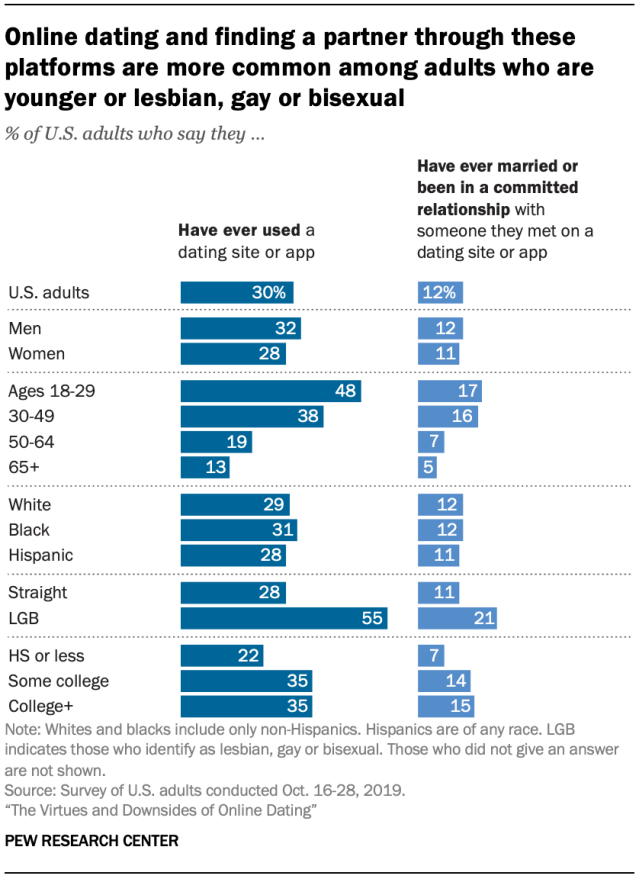
Of people who were in a relationship, 11% of straight people and 21% of 18-29s had met their partners online more generally. Thankfully they broke down the specific online venues that people met through. Only a slight majority, 61% had met through online dating. 21% met through social media, 10% through a forum, 3% through messaging apps, and 3% through online gaming. This means that a total of 7.3% of couples had met through online dating.
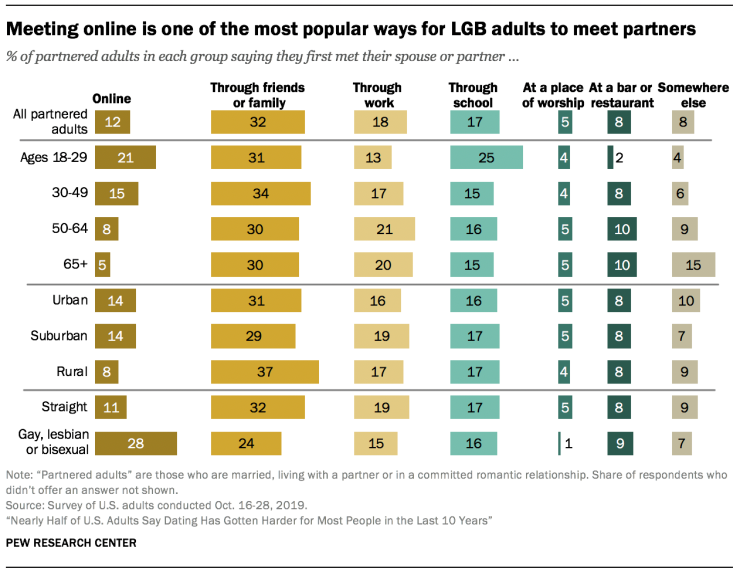
In another Pew Research survey conducted in July of 2022, there was no change in the percentage of people who’d used online dating before. 9% of partnered straight adults had met their partner through online dating. 20% of 18-29s had.
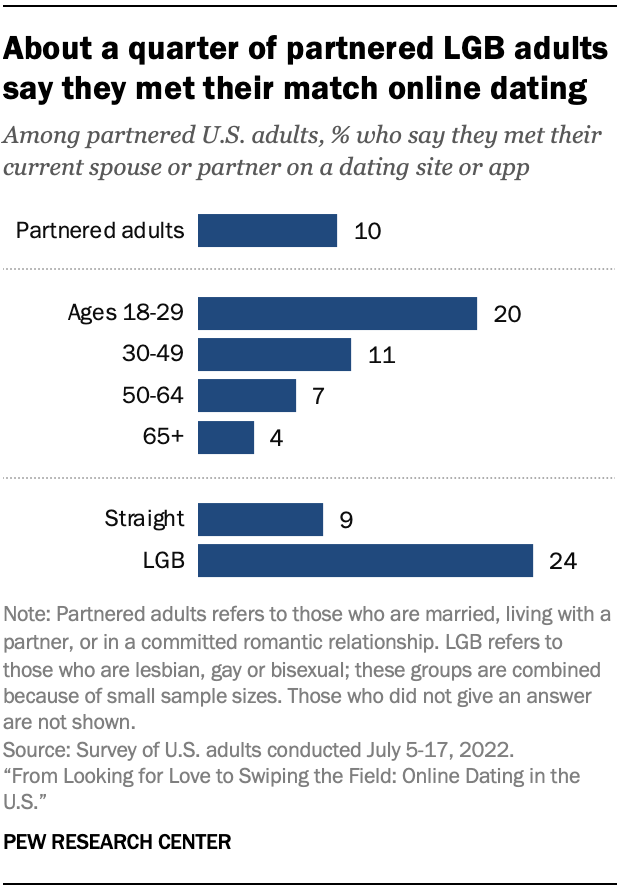
Morning Consult similarly found that 13% met their spouse, partner, or person they most recently dated online in 2021, up only slightly from 10% in 2018.
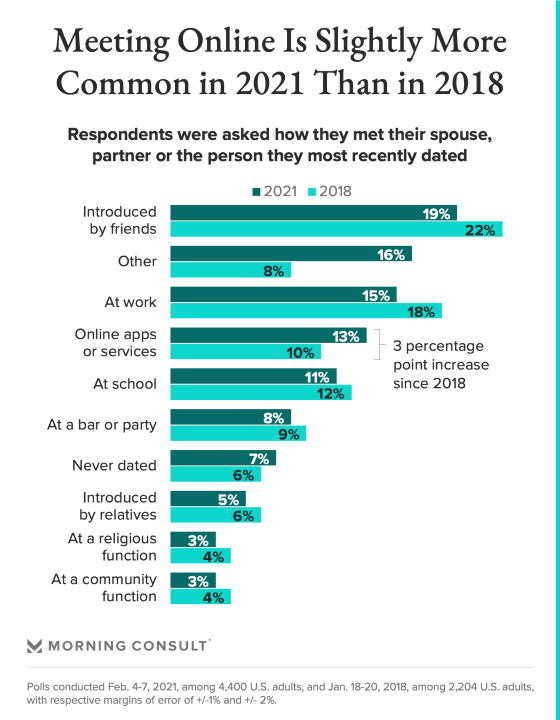
The 2018 survey also found that of the 29% who had used online dating, 23% of people had met a long-term romantic partner through it. Actually less 18-29s had (17%), though more of them had used it before (44%). This means that 6.7% of adults and 7.5% of 18-29s had ever been in a relationship through OLD.

YouGov trackers with about 1,000 respondents per wave shows that from Dec 2020 to Nov 2023 on average 4.9% of Americans met their partners through dating websites and 4.4% through dating apps. Since 16.8% hadn’t had a partner before, this means that 5.9% of those who had had a partner before having met their most recent partner through dating websites and 5.3% through dating apps, for a total of 11.2%. There’s also no indication of an increase in the amount of people meeting online across this timeframe. For 18-29s, on average 6.9% had met through a dating app and 4% through a dating website. 21.5% hadn’t had a partner. This translates to 8.8% of those who’ve had a partner having met their most recent one through dating apps and 5.1% through dating websites for a total of 13.9%. Again, no indication of an increase but if anything the opposite trend.
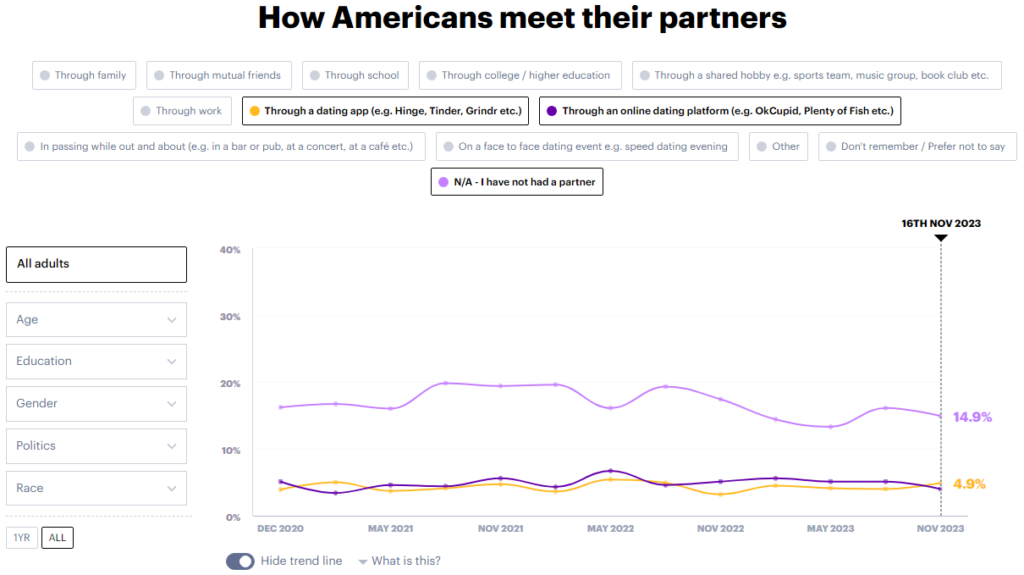
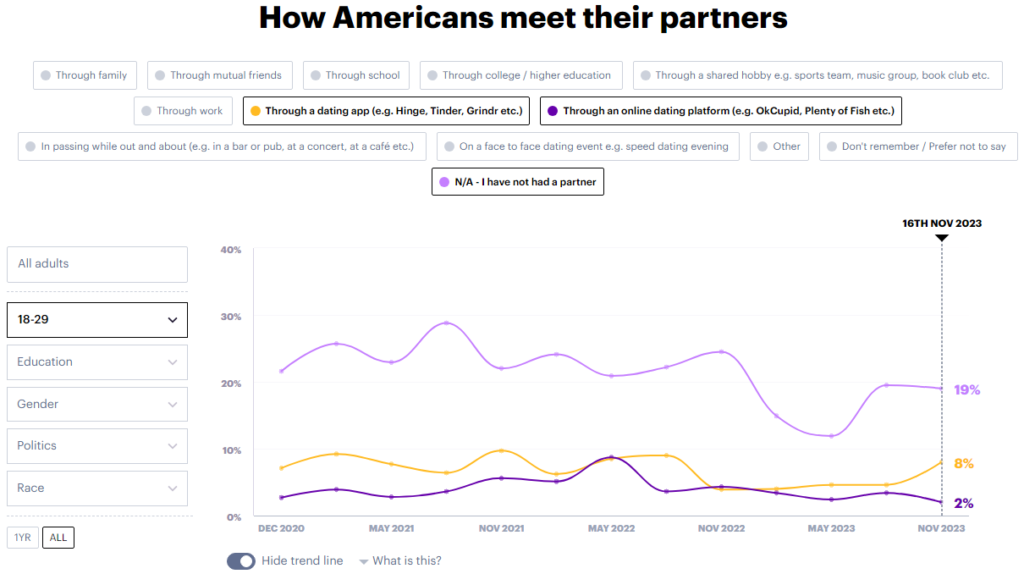
For Britain, with about 2,000 respondents per wave, from July 2019 to December 2023 about 6.7% had met their most recent partners through a dating app and 4.7% through a dating website. 14.7% hadn’t had a partner before. This translates to 7.9% of those who had had a partner having met their most recent partner through a dating app and 5.5% through a dating website overall, for a total of 13.4%. We see an indication of a marginal increase for dating apps. For 18-24 Brits, 9.8% met their most recent partner through a dating app and 1.5% through a dating website. 36.8% hadn’t had a partner before. This translates to 15.5% through a dating app and 2.4% through a dating website, for a total of 17.9%.
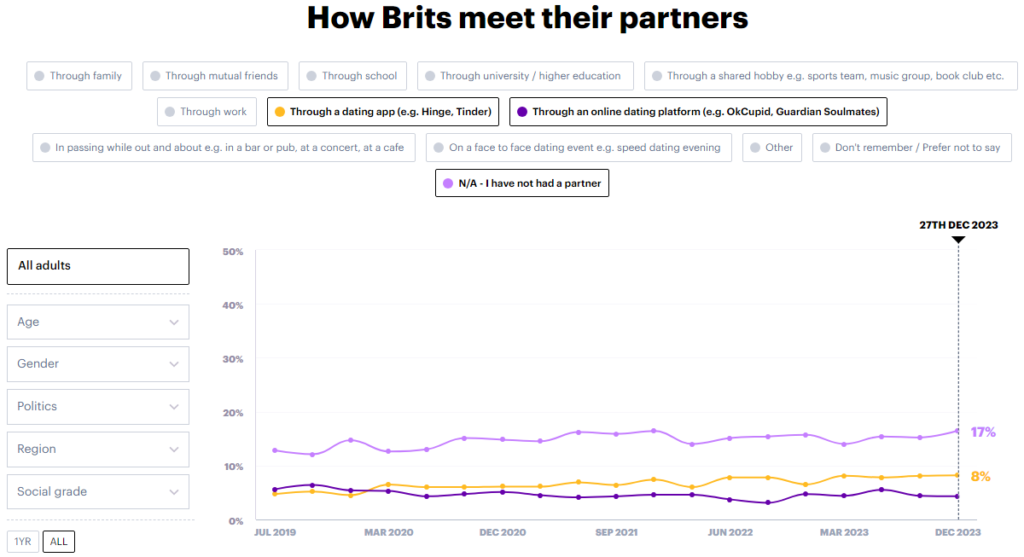
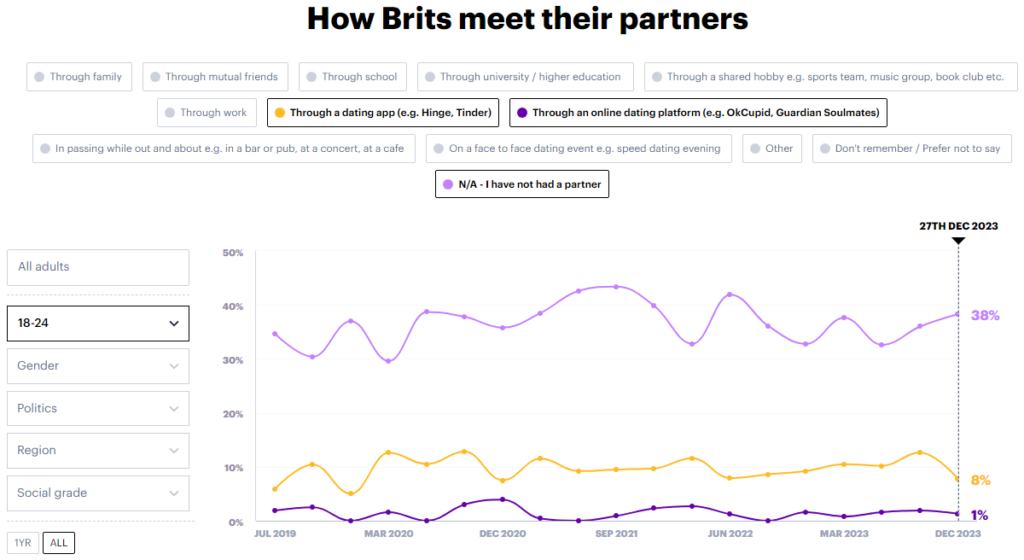
A global online YouGov survey in August 2021 of people from 17 countries found varying rates from 5% to 16% for people having met their partner through mobile apps.
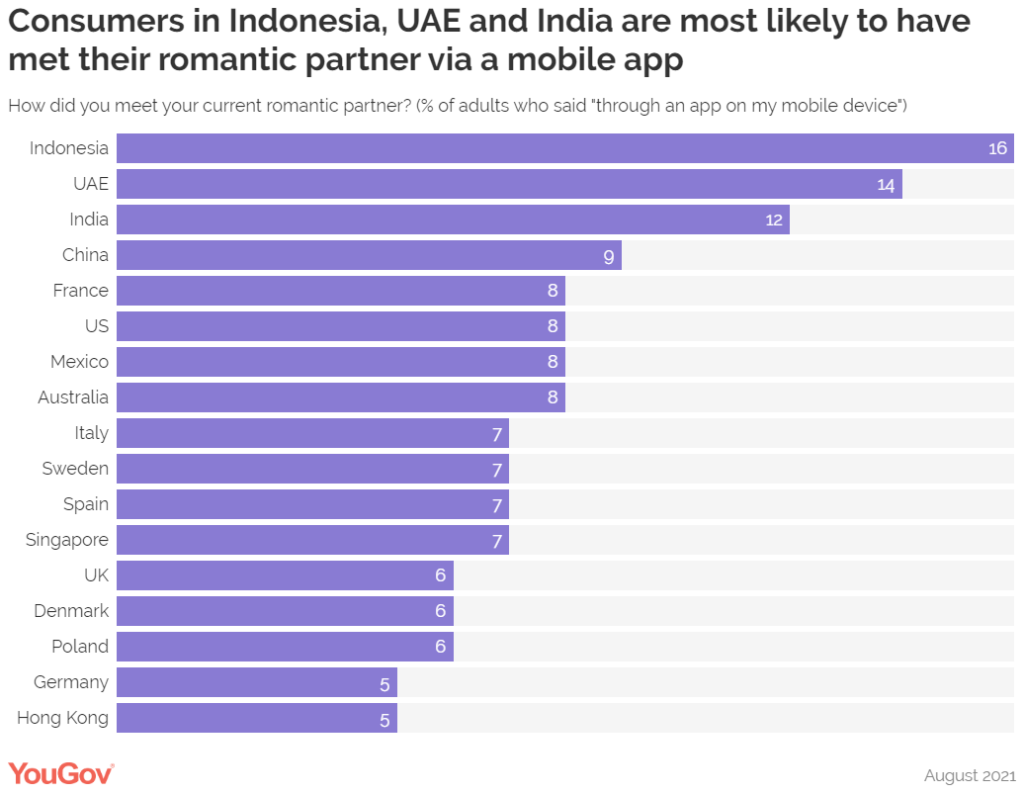
On average, 16% of 25-34s had met their current partner through an app. Slightly less 18-24s had at 13%, maybe due to still having opportunities to meet people at school.
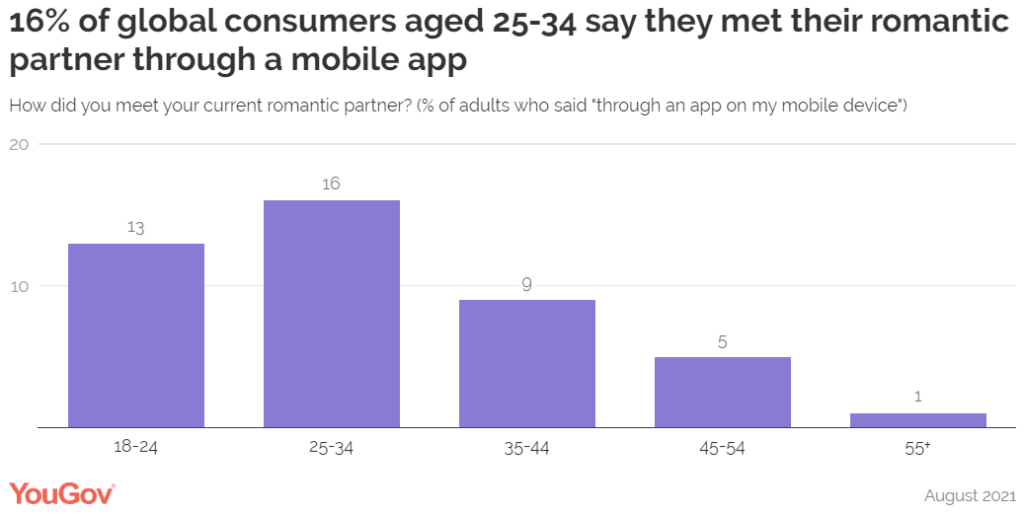
A 2022 YouGov survey of 3,900 Brits found that 18% had ever met someone through a dating app. This number was again slightly lower for zoomers (22%) than millennials (26%). About half of both groups had never even touched a dating app in their lives.
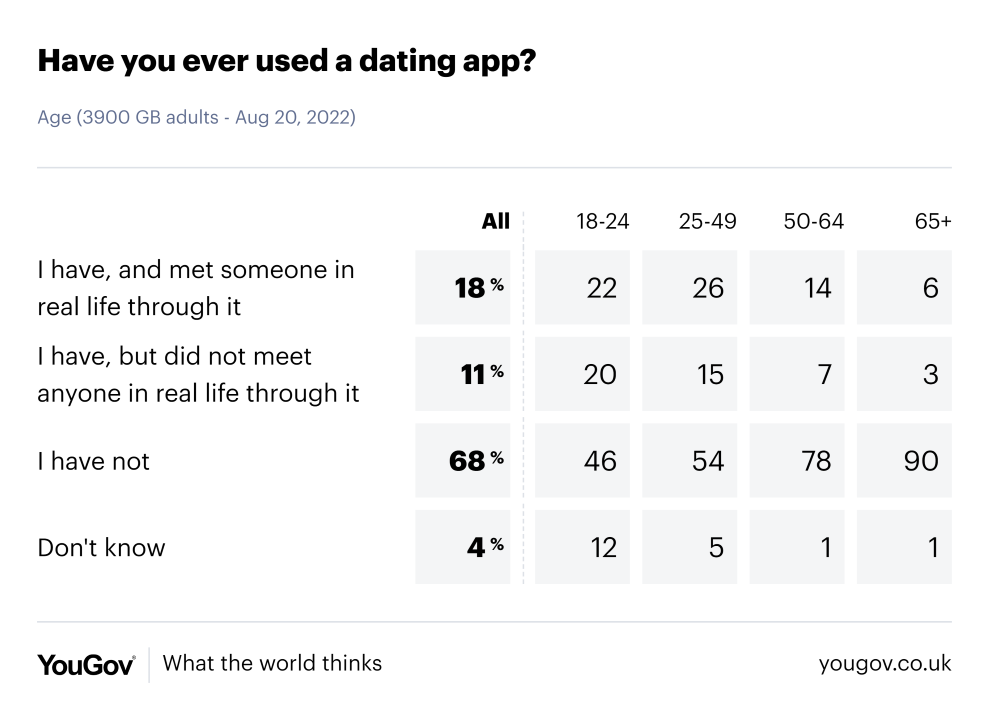
According to the January 2023 American Perspectives Survey, 11% of people had met their partners through an online dating website or app. The percentages were 28% for 18-29 men and 14% for 18-29 women.
It was also found that 44% of 18-29s were friends with their partners before dating, more than older age groups, though it could also be the case that it’s more of an age than a cohort effect. Only 35% were unacquainted before dating.
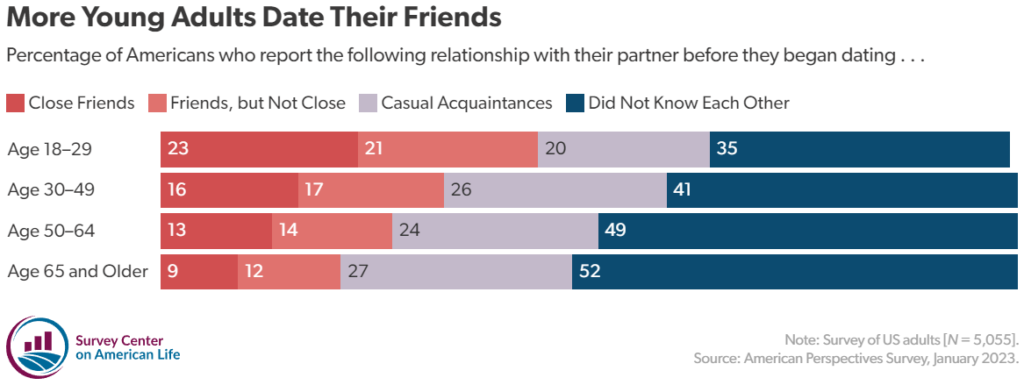
These findings are supported by Stinson et al. (2022), which found from a total of 1,897 participants over 7 studies conducted between 2002 and 2020 an estimated average log-odds of 0.66 for relationships beginning as platonic friendships. So much for the friendzone?
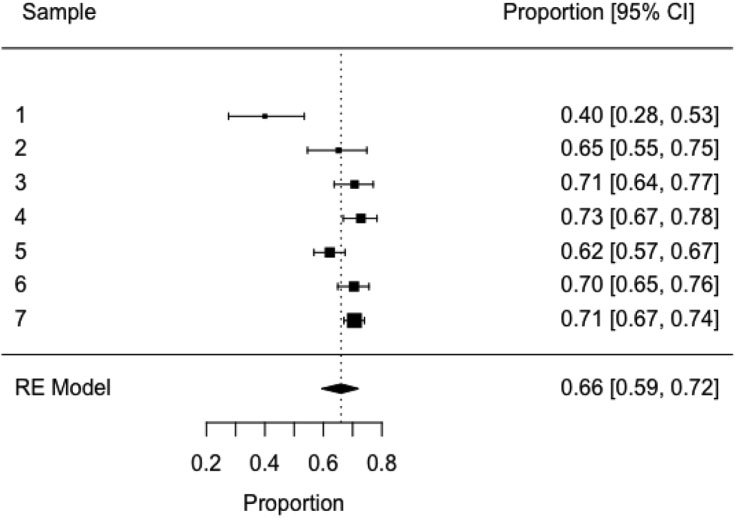
The rate wasn’t lower in the most recent sample either, and it was higher among those under (84%) than those over 30 (69%). 70.3% in study 4 stated that neither they nor their partner intentionally became friends due to attraction or romantic interest and that it instead developed after getting to know each other. To play devil’s advocate, it’s possible that they just weren’t consciously aware of it, or if they were actively unattracted to them that they wouldn’t have developed attraction to them or even perhaps became friends to begin with. Online dating was also highly unpopular, with only 0.3% stating that online dating was the best way to meet a partner, and 0.7% saying an online community/social media.
The 2022 Singles in America Survey (conducted by Match.com) found that 16.7% of singles had met their most recent first date through online dating, and 8.9% through social media, for a total of 25.6% online overall (excluding any potential online venues included in ‘other’).
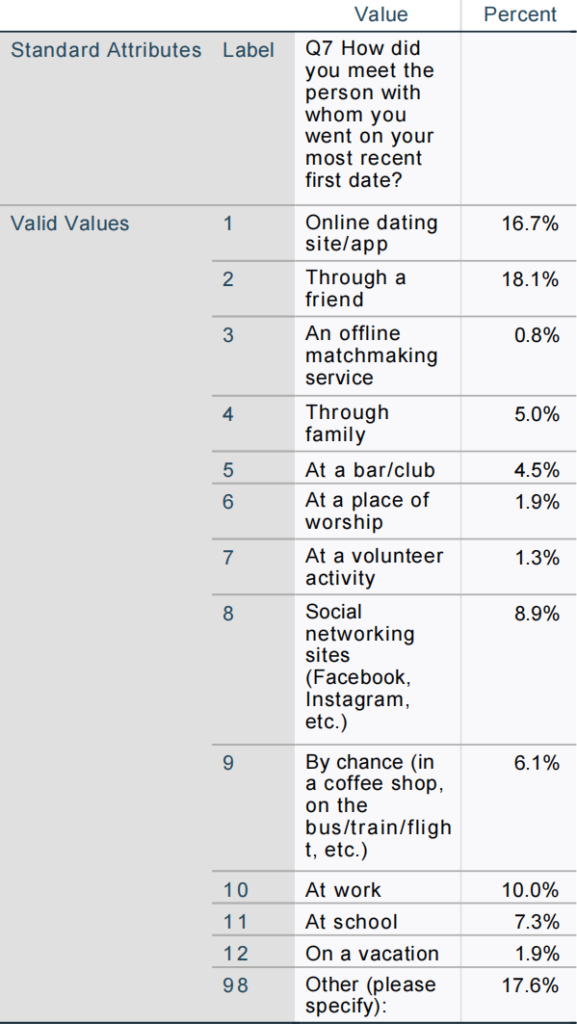
A survey conducted by Zola of 4,249 engaged American couples conducted in 2022 found that 27% had met through an online dating service or app. Slightly more met at school.
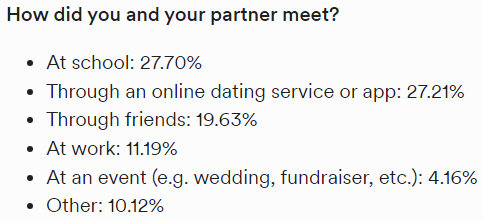
A survey conducted by The Knot of 11,646 couples married in 2022 found that 29% of Millennials aged 26-41 had met online while interestingly less Zoomers aged 18-25, 15%, had done.
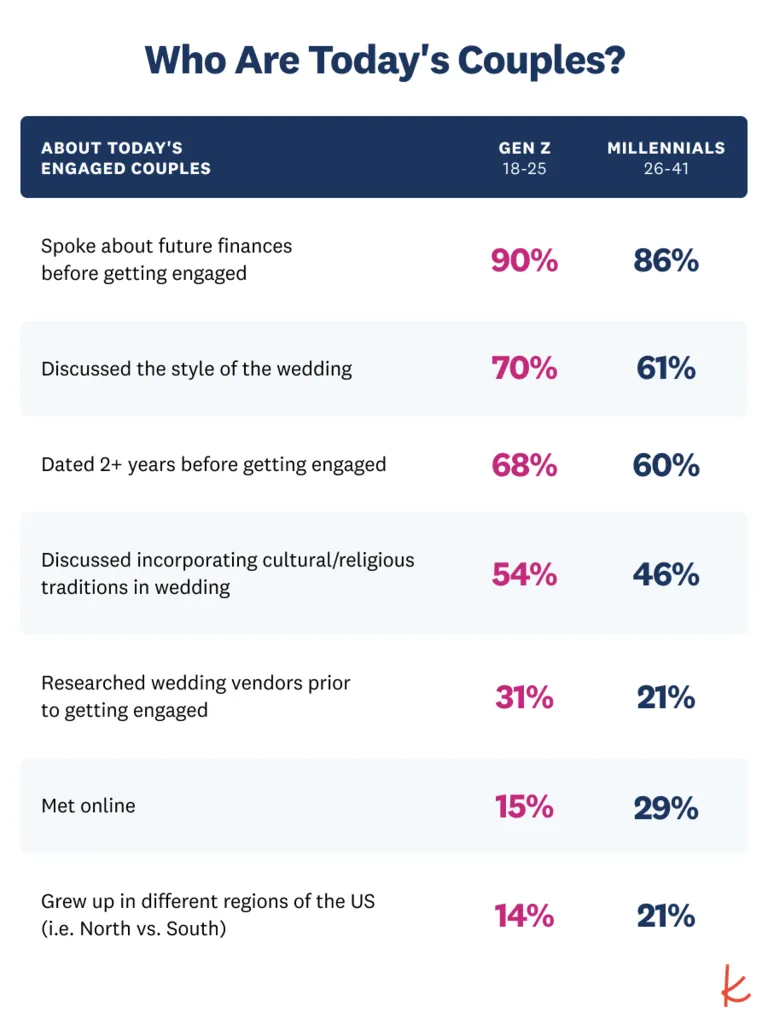
A study by the UK’s Marriage Foundation in 2021 found among 955 unmarried 18-30s that 29% met online, with about an even split between those who met on a ‘casual dating app’ or another online app.
Update: Recently released survey data from the 2023 American Perspectives Survey allows us with a good deal of confidence to respond to this article’s question in the negative.
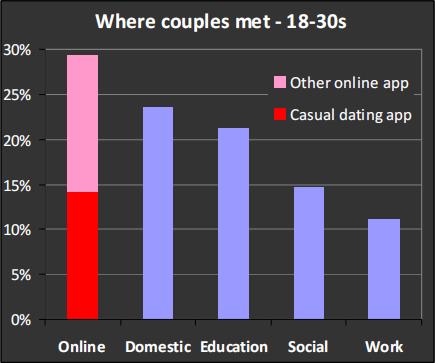
Another study by the Marriage Foundation in 2021 found that 28% of those who’d married since 2017 had met online.
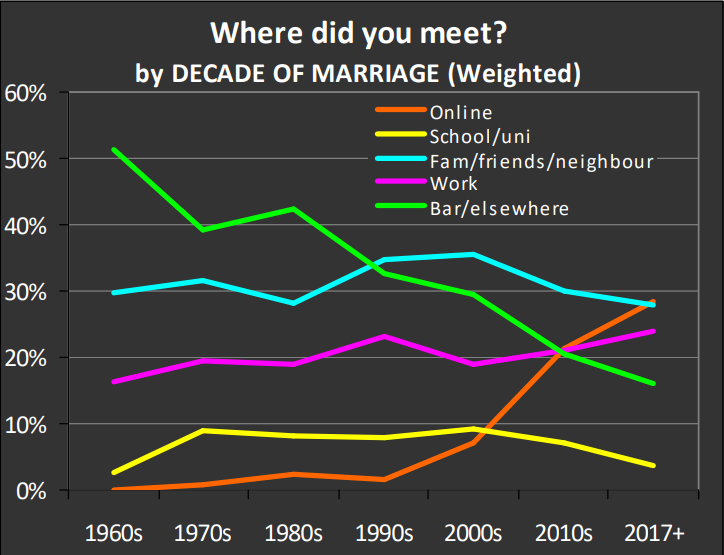
Potarca (2020) found from the Swiss 2018 Family and Generations Survey that the proportion of couples meeting online rose from 0% in 1995 to about 25% in 2017-18. A bit over 10% had met their partners through dating apps in 2017-18, about 7% met through dating websites and another 7% through ‘other online’. The authors suggest that Switzerland’s higher population density and stronger attachment to local informal ties may explain the higher rate seen in the US.
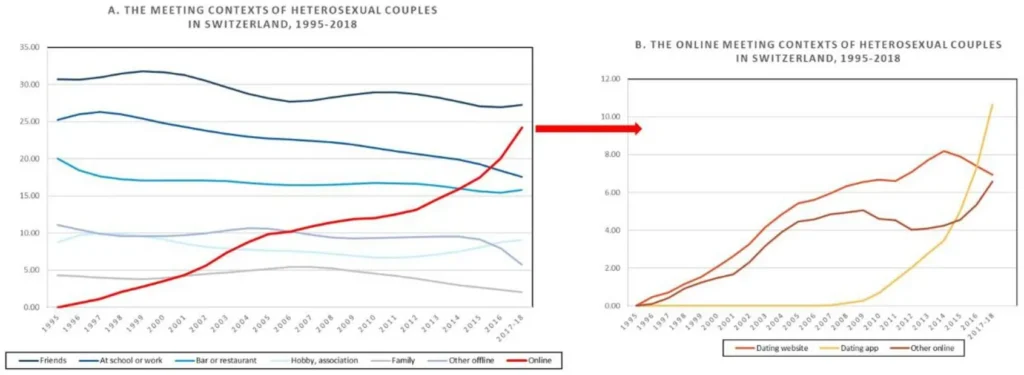
Reconciling The Data
Something strange is going on. When we look at these sources which ask how people met their current or most recent partner, we consistently see the percentage reporting online dating hovering around 10%, and these are from more recent years than the 2017 HCMST survey which found some 4x as many meet online.
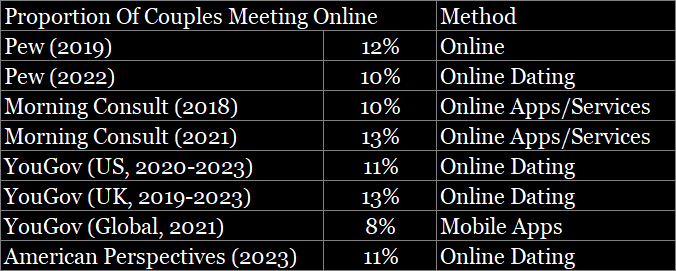
How do we account for this incongruence? A large reason why will be that the HCMST asks for the specific year that people met their partners. The percentage of people who’d met their partner in 2017 is clearly going to be higher than the percentage in 2017 who’d met their current or most recent partner online regardless of when, as this could’ve been anywhere from yesterday to over a decade ago when online dating was a lot smaller. Another thing is that it simply says ‘online’. Many people have taken this to mean ‘online dating’, but as we’ve seen there are other online venues through which people meet.
Even with this in mind however, none of the figures came close to reaching 40%, let alone upwards of 50%, even those which were also for couples who’d met recently and which also referred to meeting online more generally. While the figures for engaged people could be somewhat misleading since people generally date a while before getting engaged, the average length of time that people date before getting engaged in the US is 2.5 years. Also, how far back could most 18-24 year olds’ relationships realistically go? In 2023, only 15% of British 18-24s reported meeting through online dating apps or websites. 6 years earlier when HCMST 2017 was conducted they would’ve been 12-18. I guess it’s possible that some hadn’t had one since before then. Moreover other online venues would likely fall under ‘other’, but only about 9% selected this.
Another potential contributing factor is that these other sources allowed only one option to be selected. It’s possible that given the choice between selecting online or at a bar where they met for instance that many will select online over the bar. This could also be the case for online meetings mediated by friends or family, though it doesn’t seem like anyone met this way in 2017.
Let’s say these factors together are enough to explain the discrepancy between the 2017 HCMST and these other sources, has it really skyrocketed up to close to 60% just a few years? To attempt to get to the bottom of this, let’s take a closer look at the data, including the actual data points and error bars, as simply showing a smoothed line could conceal a more nuanced picture.
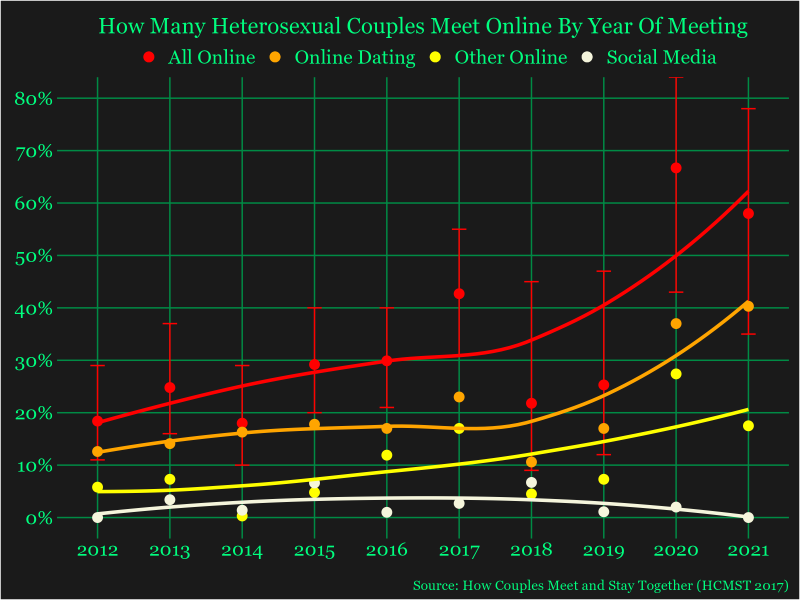
Indeed, it’s quite a lot more fuzzy than one might’ve imagined. We don’t just see an incremental increase from 2017 but rather a quite steep fall to 20-25% for the next two years, then suddenly surging by over 150% to almost 70%, then dropping to a bit under 60%.
From the 6,519 sample size on the graph posted on reddit (not sure where the extra ~1,000 is coming from) one might’ve expected a high degree of reliability in estimates, but we need to remember that these data points represent the percentage of people who’d met their partners on that particular year. As you should be able to tell from the error bars, the number of heterosexuals in the follow up surveys who’d met their partners in the years following 2017 was not exactly a lot. In 2018 it was 18, in 2019 21, in 2020 17, in 2021 17, and since only 4 met in 2022 I left it out. While some people may underestimate how small a sample size can be while still maintaining good generalizability, there is a limit. Even in 2017 it was nothing to write home about, with 60 heterosexuals meeting their partners on this year, allowing for an error margin of 12%.
Beyond this issue of noisy data, what event may have influenced the outcomes during these years? Any takers? Of the people who did meet a partner during this trying time, it makes sense that it would’ve been disproportionately online when social interactions outside the house were so restricted. For these reasons I believe that the graph is quite misleading. We aren’t justified in drawing conclusions from such weak and potentially confounded data.
We also see that a substantial number, somewhere between 25-50% of those meeting online meet through venues other than dating websites or apps. Surprisingly, in this dataset at least ‘social networking’ looks to be a relatively small portion of this however, with most being in the mysterious ‘other’ category. There were also ‘game’, ‘chat’, and ‘org’ options, but few met through these either so I lumped them in with other. To be fair, it could be that many of those in the other category did actually meet through online dating but just didn’t specify it, as it was inferred from their written descriptions which may have sometimes been overly vague.
Conclusion
So have we officially tipped over the 50% mark as many have been awaiting with bated breath? I don’t have a hard answer, but I also don’t think anyone else can claim to either from this highly limited data. It’s best not to jump the gun, we’ve seen the danger of making hasty judgments like this. If I had to bet I’d say no given the context explored here. From the other data it doesn’t look to be rapidly rising at this stage either. Match Group doesn’t seem to be performing too well these days:
Match Group, the parent company of dating apps Tinder and Hinge, is trading at its lowest price since it spun out into a separate company from IAC in July 2020. The stock closed down more than 15% to about $29 per share … People paying for Tinder fell 6% in comparison to the same period a year ago.
CNBC
Are zoomers actually less of a fan of dating apps than millennials as the data indicated? It might be a surprise considering how we tend to view younger generations as becoming more and more screen addicted (which they probably are). This is also reflected in self-reports though, with the 2021 Morning Consult survey showing that zoomers had worse sentiments towards and experiences with dating apps than millennials. Of course part of the drop may just be people less interested in dating in general.
If society is becoming as atomized as people say it is, it would seem inevitable that at some point most couples will have began online. What the implications of this would be I’m not exactly sure. What we can be confident in saying is that fears of ‘chad harems’ are are probably unwarranted. From what I’ve seen there have so far been mixed findings on outcomes for relationships beginning through online dating vs. more conventional methods of meeting. While there is a wider pool available with the potential to facilitate compatibility (though most don’t do a great job), there’s also more ambiguity around people when you’re unacquainted and lack mutual connections. People also tend to state a preference for meeting people more ‘organically’, and building a connection over time. I guess that’s the paradox we’re dealing with. Though again, maybe to a lesser extent than the graph would imply.
Postscript: recently released data from the 2023 American Perspectives Survey allows us to respond to this article’s question in the negative with a good deal of confidence.
References
Rosenfeld, M. J., Thomas, R. J., & Hausen, S. (2019). Disintermediating your friends: How online dating in the United States displaces other ways of meeting. Proceedings of the National Academy of Sciences of the United States of America, 116(36), 17753–17758. https://doi.org/10.1073/pnas.1908630116
Anderson, M., Vogels, E. A., & Turner, E. (2020). The Virtues and Downsides of Online Dating. Pew Research Center. https://www.pewresearch.org/internet/2020/02/06/the-virtues-and-downsides-of-online-dating/
Brown, A. (2020). Nearly Half of U.S. Adults Say Dating Has Gotten Harder for Most People in the Last 10 Years. Pew Research Center. https://www.pewresearch.org/social-trends/2020/08/20/nearly-half-of-u-s-adults-say-dating-has-gotten-harder-for-most-people-in-the-last-10-years/
Vogels, E. A., & McClain, C. (2023). Key findings about online dating in the U.S. Pew Research Center. https://www.pewresearch.org/short-reads/2023/02/02/key-findings-about-online-dating-in-the-u-s/
Meyers, A. (2021). Spurred On by COVID-19, Millennials Lead the Way in Destigmatizing Online Dating. Morning Consult. https://pro.morningconsult.com/articles/online-dating-stigma-amid-pandemic
https://today.yougov.com/topics/society/trackers/meet-latest-partner
https://yougov.co.uk/topics/society/trackers/how-brits-meet-their-partners
YouGov (2021). A global look at who has found love through an app. YouGov. https://today.yougov.com/technology/articles/38298-global-look-who-has-found-love-through-app
Cox, D. A. (2023). From Swiping to Sexting: The Enduring Gender Divide in American Dating and Relationships. The Survey Center on American Life. https://www.americansurveycenter.org/research/from-swiping-to-sexting-the-enduring-gender-divide-in-american-dating-and-relationships/#_edn2
Stinson, D. A., Cameron, J. J., & Hoplock, L. B. (2022). The Friends-to-Lovers Pathway to Romance: Prevalent, Preferred, and Overlooked by Science. Social Psychological and Personality Science, 13(2), 562-571. https://doi.org/10.1177/19485506211026992
Forest, E. (2023). The First Look Report 2023 Deep Data Dive. Zola. https://www.zola.com/expert-advice/the-first-look-report-2023-deep-data-dive
The Knot (2023). The Knot 2022 Real Weddings Study. The Knot. https://www.theknot.com/content/wedding-data-insights/real-weddings-study
Benson, H. (2021). Casual daters seek long term happiness. Marriage Foundation. https://marriagefoundation.org.uk/wp-content/uploads/2021/02/MF-note-casual-daters-seek-reliable-love.pdf
Benson, H. (2021). Relative Strangers: The Importance of Social Capital for Marriage. Marriage Foundation. https://marriagefoundation.org.uk/wp-content/uploads/2021/10/MF-Risk-of-online-weddings-v6.pdf
Potarca G. (2020). The demography of swiping right. An overview of couples who met through dating apps in Switzerland. PloS one, 15(12), e0243733. https://doi.org/10.1371/journal.pone.0243733
Gionet, A. (2023). Proposal Timelines: How Long Do American Couples Wait Before Getting Engaged?. Shane Co. https://www.shaneco.com/theloupe/jewelry-education/art-of-engagement/how-soon-is-too-soon-to-propose/

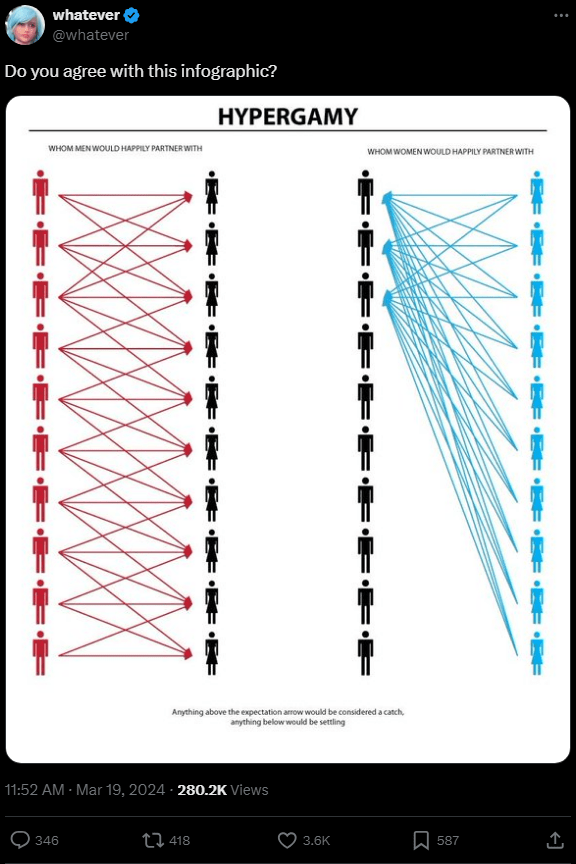
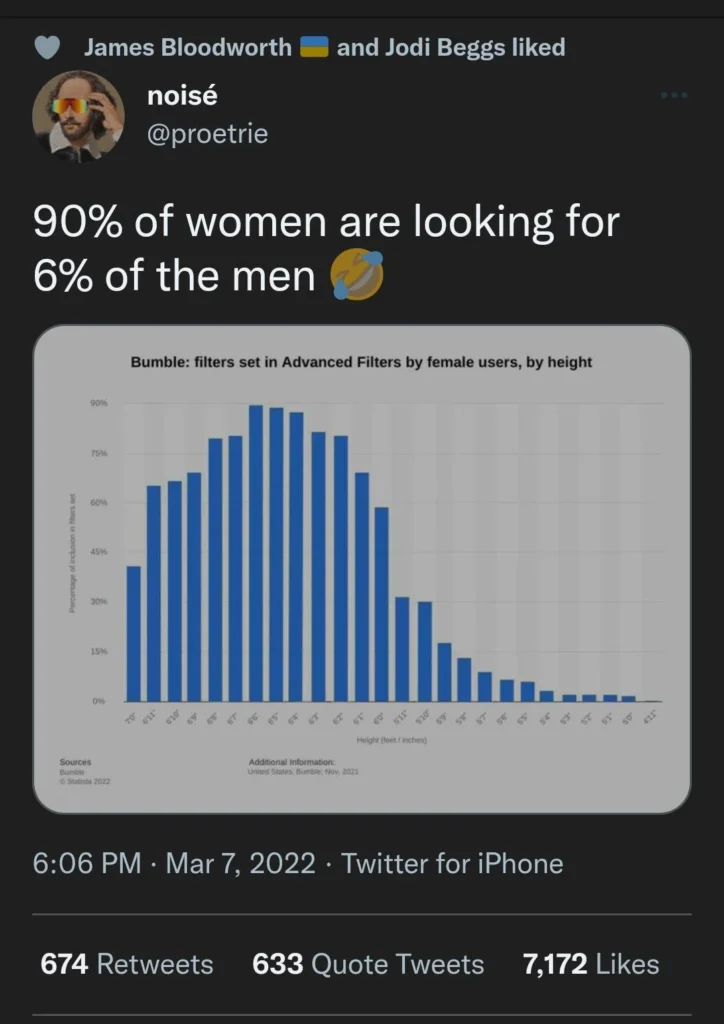
Thank you for the auspicious writeup It in fact was a amusement account it Look advanced to more added agreeable from you By the way how could we communicate
Someone essentially assisted me in composing substantial articles. I would say that this is the very first time I have visited your website, and thus far I am impressed with the research you conducted to produce this outstanding submission. Well done.
Thank you for the auspicious writeup It in fact was a amusement account it Look advanced to more added agreeable from you By the way how could we communicate
Hi my loved one I wish to say that this post is amazing nice written and include approximately all vital infos Id like to peer more posts like this
Hi Neat post Theres an issue together with your web site in internet explorer may test this IE still is the marketplace chief and a good component of people will pass over your fantastic writing due to this problem
What i do not understood is in truth how you are not actually a lot more smartlyliked than you may be now You are very intelligent You realize therefore significantly in the case of this topic produced me individually imagine it from numerous numerous angles Its like men and women dont seem to be fascinated until it is one thing to do with Woman gaga Your own stuffs nice All the time care for it up
My brother recommended I might like this web site He was totally right This post actually made my day You cannt imagine just how much time I had spent for this information Thanks
I just could not leave your web site before suggesting that I really enjoyed the standard information a person supply to your visitors Is gonna be again steadily in order to check up on new posts